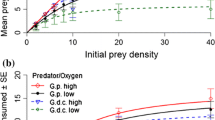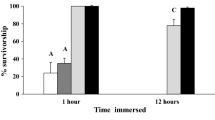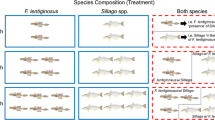Abstract
Ecological impacts of invasive species are mediated by the environmental characteristics of the invaded habitats. The invasive round goby Neogobius melanostomus is a brackish-water adapted invader with high predatory and competitive impacts on native communities. We test the hypothesis that both body mass gain and predation rates of the round goby are reduced in low-dissolved ion waters in which they can establish, using calcium (Ca2+) as a focal ion of great importance to the physiology of aquatic animals. Round gobies were first acclimated for 36 days on a diet of shrimp pellets in either high (35 mg L−1) or low (12 mg L−1) Ca2+ concentration [Ca]. We then assessed the functional response (FR)—the relationship between predation rate and prey supply—of the round goby from high and low [Ca] on amphipod prey in either condition. Round gobies in high [Ca] consumed more pellets during the acclimation period and gained more mass compared to fish in low-[Ca] conditions. Functional response experiments revealed that round gobies at high-[Ca] levels for both acclimation and FR experiments had the highest predatory impact, whereas fish in low-[Ca] FR treatments had similarly low predation rates regardless of acclimation [Ca]. In a second experiment, non-acclimated round gobies had a higher FR on mayfly nymph prey at high [Ca] than fish at low-[Ca] levels. Our results indicate that the round goby has stronger ecological impacts in conditions that are more physiologically optimal for the species. Identifying key physico-chemical factors that mediate impacts of invaders would help prioritize habitats for management attention.



Similar content being viewed by others
References
Alcaraz C, Bisazza A, Garcia-Berthou E (2008) Salinity mediates the competitive interactions between invasive mosquitofish and an endangered fish. Oecologia 155:205–213
Alexander ME, Dick JTA, O’Connor NE, Haddaway NR, Farnsworth KD (2012) Functional responses of the intertidal amphipod Echinogammarus marinus: effects of prey supply, model selection and habitat complexity. Mar Ecol Prog Ser 468:191–202
Alexander ME, Dick JTA, Weyl OLF, Robinson TB, Richardson DM (2014) Existing and emerging high impact invasive species are characterized by higher functional responses than natives. Biol Lett 10:20130946
Astorga N, Afonso JM, Zamorano MJ, Montero D, Oliva V, Fernandez H, Izquierdo MS (2005) Evaluation of visible implant elastomer tags for tagging juvenile gilthead seabream (Sparus auratus L.); effects on growth, mortality, handling time and tag loss. Aquac Res 36:733–738
Baldwin BS, Carpenter M, Rury K, Woodward E (2012) Low dissolved ions may limit secondary invasion of inland waters by exotic round gobies and dreissenid mussels in North America. Biol Invasions 14:1157–1175
Barrios-O’Neill D, Dick JTA, Emmerson MC, Ricciardi A, MacIsaac HJ, Alexander ME, Bovy HC (2014) Fortune favours the bold: a higher predator reduces the impact of a native but not an invasive intermediate predator. J Anim Ecol 83:693–701
Berg A (1970) Studies on the metabolism of calcium and strontium in freshwater fish. II. Relative contribution of direct and intestinal absorption in growth conditions. Memorie dell’Istituto Italiano di Idrobiologia 26:241–255
Bolker BM (2010) bbmle: Tools for general maximum likelihood estimation. R package version 1.0.15. http://CRAN.R-project.org/package=bbmle
Bomford M, Barry SC, Lawrence E (2010) Predicting establishment success for introduced freshwater fishes: a role for climate matching. Biol Invasions 12:2559–2571
Brandner J, Cerwenka AF, Schliewen UK, Geist J (2013) Bigger is better: characteristics of round gobies forming an invasion front in the Danube River. PLoS ONE 8:e73036
Britton JR, Cucherousset J, Davies GD, Godard MJ, Copp GH (2010) Non-native fishes and climate change: predicting species responses to warming temperatures in a temperate region. Freshw Biol 55:1130–1141
Campbell LM, Thacker R, Barton D, Muir DCG, Greenwood D, Hecky RE (2009) Re-engineering the eastern Lake Erie littoral food web: the trophic function of non-indigenous Ponto-Caspian species. J Great Lakes Res 35:224–231
Charlebois PM, Marsden JE, Goettel RG, Wolfe RK, Jude DJ, Rudnicka S (1997) The round goby, Neogobius melanostomus (Pallus), a review of European and North American literature. INHS Special Publication No. 20. Illinois–Indiana Sea Grant Program, Urbana, Illinois, USA and Illinois Natural History Survey, Champaign, Illinois, USA
Costanzo KS, Kesavaraju B, Juliano SA (2005) Condition-specific competition in container mosquitoes: the role of noncompeting life-history stages. Ecology 86:3289–3295
Dick JTA (1996) Post-invasion amphipod communities of Lough Neagh, Northern Ireland: influences of habitat selection and mutual predation. J Anim Ecol 65:756–767
Dick JTA, Gallagher K, Avlijas S, Clarke H, Lewis S, Leung S, Minchin D, Caffrey J, Alexander M, Maguire C, Harrod C, Reid N, Haddaway N, Farnsworth K, Penk M, Ricciardi A (2013) Ecological impacts of an invasive predator explained and predicted by comparative functional responses. Biol Invasions 15:837–846
Dick JTA, Alexander ME, Jeschke JM, Ricciardi A, MacIsaac HJ, Robinson TB, Kumschick S, Weyl OLF, Dunn AM, Hatcher MJ, Paterson RA, Farnsworth KD, Richardson DM (2014) Advancing impact prediction and hypothesis testing in invasion ecology using a comparative functional response approach. Biol Invasions 16:735–753
Edwards BA, Lewis VRE, Rodd FH, Jackson DA (2013) Interactive effects of calcium decline and predation risk on the potential for a continuing northward range expansion of the rusty crayfish (Orconectes rusticus). Can J Zool 91:328–337
Epifanio CE, Dittel AI, Park S, Schwalm S, Fouts A (1998) Early life history of Hemigrapsus sanguineus, a non-indigenous crab in the Middle Atlantic Bight (USA). Mar Ecol Prog Ser 170:231–238
Flik G, Fenwick JC, Kolar Z, Mayergostan N, Bonga SEW (1986) Effects of low ambient calcium levels on whole-body Ca2+ flux rates and internal calcium pools in the freshwater cichlid teleost, Oreochromis mossambicus. J Exp Biol 120:249–264
French JRP, Jude DJ (2001) Diets and diet overlap of nonindigenous gobies and small benthic native fishes co-inhabiting the St. Clair River, Michigan. J Great Lakes Res 27:300–311
Hellmann JJ, Byers JE, Bierwagen BG, Dukes JS (2008) Five potential consequences of climate change for invasive species. Conserv Biol 22:534–543
Holling CS (1959) Some characteristics of simple types of predation and parasitism. Can Entomol 92:385–398
Holling CS (1966) The functional response of invertebrate predators to prey density. Mem Entomol Soc Can 48:1–86
Hunn JB (1985) Role of calcium in gill function in freshwater fishes. Comp Biochem Physiol 82A:543–547
Iacarella JC, Dick JTA, Alexander ME, Ricciardi A (2015) Ecological impacts of invasive alien species along temperature gradients: testing the role of environmental matching. Ecol Appl 25:706–716
Jeschke JM, Kopp M, Tollrian R (2002) Predator functional responses: discriminating between handling and digesting prey. Ecol Monogr 72:95–112
Jokela A, Ricciardi A (2008) Predicting zebra mussel fouling on native mussels from physicochemical variables. Freshw Biol 53:1845–1856
Jones LA, Ricciardi A (2005) Influence of physicochemical factors on the distribution and biomass of invasive mussels in the St. Lawrence River. Can J Fish Aquat Sci 62:1953–1962
Juliano S (2001) Nonlinear curve fitting. In: Scheiner SM, Gurevitch J (eds) Design and analysis of ecological experiments. Chapman and Hall, New York, pp 179–196
Kestrup AM, Ricciardi A (2009) Environmental heterogeneity limits the local dominance of an invasive freshwater crustacean. Biol Invasions 11:2095–2105
Kestrup A, Ricciardi A (2010) Influence of conductivity on life history traits of exotic and native amphipods in the St. Lawrence River. Fund Appl Limnol 176:249–262
Kim N, Walseng B, Yan ND (2012) Will environmental calcium declines hinder Bythotrephes establishment success in Canadian Shield lakes? Can J Fish Aquat Sci 69:810–820
Kipp R, Ricciardi A (2012) Impacts of the Eurasian round goby (Neogobius melanostomus) on benthic communities in the upper St. Lawrence River. Can J Fish Aquat Sci 69:469–486
Kornis MS, Mercado-Silva N, Vander Zanden MJ (2012) Twenty years of invasion: a review of round goby Neogobius melanostomus biology, spread and ecological implications. J Fish Biol 80:235–285
MacNeil C, Prenter J, Briffa M, Fielding NJ, Dick JTA, Riddell GE, Hatcher MJ, Dunn AM (2004) The replacement of a native freshwater amphipod by an invader: roles for environmental degradation and intraguild predation. Can J Fish Aquat Sci 61:1627–1635
Malone JC, Forrester GE, Steele MA (1999) Effects of subcutaneous microtags on the growth, survival, and vulnerability to predation of small reef fishes. J Exp Marine Biol Ecol 237:243–253
McMahon RF, Bogan AE (2001) Mollusca: Bivalvia. In: Thorp JH, Covich AP (eds) Ecology and classification of North American freshwater invertebrates. Academic Press, San Diego, pp 331–429
Olsen EM, Vollestad LA (2001) An evaluation of visible implant elastomer for marking age-0 brown trout. N Am J Fish Manage 21:967–970
Parker IM, Simberloff D, Lonsdale WM, Goodell K, Wonham M, Kareiva PM, Williamson MH, Von Holle B, Moyle PB, Byers JE, Goldwasser L (1999) Impact: toward a framework for understanding the ecological effects of invaders. Biol Invasions 1:3–19
Paterson RA, Dick JTA, Pritchard DW, Ennis M, Hatcher MJ, Dunn AM (2014) Predicting invasive species impacts: a community module functional response approach reveals context dependencies. J Anim Ecol 84:453–463
Peterson AT (2003) Predicting the geography of species’ invasions via ecological niche modeling. Q Rev Biol 78:419–433
Pörtner HO, Knust R (2007) Climate change affects marine fishes through the oxygen limitation of thermal tolerance. Science 315:95–97
Rahel FJ, Olden JD (2008) Assessing the effects of climate change on aquatic invasive species. Conserv Biol 22:521–533
Reid DF, Orlova MI (2002) Geological and evolutionary underpinnings for the success of Ponto-Caspian species invasions in the Baltic Sea and North American Great Lakes. Can J Fish Aquat Sci 59:1144–1158
Ricciardi A, Atkinson SK (2004) Distinctiveness magnifies the impact of biological invaders in aquatic ecosystems. Ecol Lett 7:781–784
Ricciardi A, Ward JM (2006) Comment on ‘‘Opposing effects of native and exotic herbivores on plant invasions’’. Science 313:298a
Ricciardi A, Hoopes MF, Marchetti MP, Lockwood JL (2013) Progress toward understanding the ecological impacts of non-native species. Ecol Monogr 83:263–282
Rogers D (1972) Random search and insect population models. J Anim Ecol 41:369–383
Thomsen MS, Olden JD, Wernberg T, Griffin JN, Silliman BR (2011) A broad framework to organize and compare ecological invasion impacts. Environ Res 111:899–908
Walther GR, Roques A, Hulme PE, Sykes MT, Pysek P, Kuhn I, Zobel M, Bacher S, Botta-Dukat Z, Bugmann H, Czucz B, Dauber J, Hickler T, Jarosik V, Kenis M, Klotz S, Minchin D, Moora M, Nentwig W, Ott J, Panov VE, Reineking B, Robinet C, Semenchenko V, Solarz W, Thuiller W, Vila M, Vohland K, Settele J (2009) Alien species in a warmer world: risks and opportunities. Trends Ecol Evol 24:686–693
Wheatly MG (1999) Calcium homeostasis in crustacea: the evolving role of branchial, renal, digestive and hypodermal epithelia. J Exp Zool 283:620–640
Yokomizo H, Possingham HP, Thomas MB, Buckley YM (2009) Managing the impact of invasive species: the value of knowing the density-impact curve. Ecol Appl 19:376–386
Acknowledgments
We thank Rachael Ryan, Sandrine Vigneron and Jean-Michel Matte for assistance with the experiments. This research was funded by the Canadian Aquatic Invasive Species Network and by a Discovery Grant from the Natural Sciences and Engineering Research Council of Canada to A.R. Additional support was provided by the Group for Interuniversity Research in Limnology and Aquatic Environment (to J.C.I.).
Author information
Authors and Affiliations
Corresponding author
Rights and permissions
About this article
Cite this article
Iacarella, J.C., Ricciardi, A. Dissolved ions mediate body mass gain and predatory response of an invasive fish. Biol Invasions 17, 3237–3246 (2015). https://doi.org/10.1007/s10530-015-0949-5
Received:
Accepted:
Published:
Issue Date:
DOI: https://doi.org/10.1007/s10530-015-0949-5




